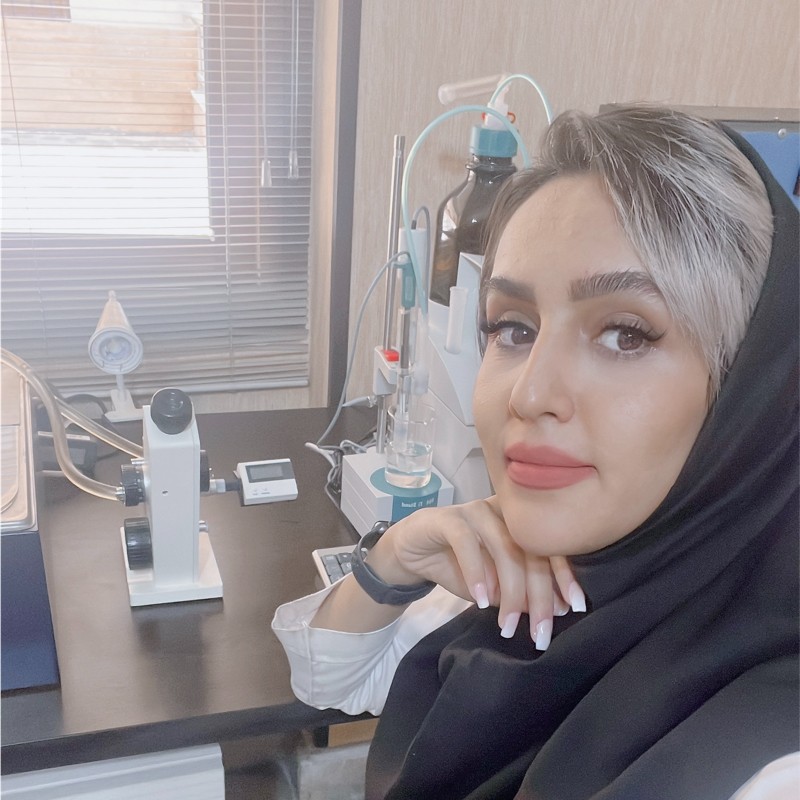Scientific Program
Keynote Session:
Title: Synthesis, characterization, and photo catalytic properties of novel nanoparticle modified Clay from different Regions in Jordan
Biography:
Research assistant, teaching assistant, and master's student with more than 3 years of experience as a research assistant at the University of Jordan, I have a strong background in Wastewater Treatment using Nanotechnology. During my research career, I have gained experience working as a research assistant on several projects. I have two research papers and a chapter under working to be published I am a hard-working person and can handle the pressures of working in the lab. I have great research skills and always strive to improve them.
Abstract:
Novel nanoparticles were prepared by modified kaolin clay with Tio2 using the sol-gel method. The aim of these prepared nanoparticles is to use these nanoparticles to purify a real sample of wastewater containing any type of dye contamination. The batch experiment was performed in the laboratory by testing modified clay in a solution containing a type of dye such as Congo red dye. Measuring degradation over time and under sunlight was made from different concentrations of clay with tio2. The best concentration was prepared which is given a degradation of 99% of the dye solution.
Title: Rare-earths co-doped lanthanum phosphate for possible application in crystalline silicon solar cells
Biography:
Abstract:
Rare-earth ions RE 3+ co-doped nano-materials have attracted much attention due to their physic-chemical resistance, photoluminescent properties, and various applications such as biomedical labels, plasma display panels, electrical conduction, fluorescent lamps, and solar cells. In recent years, considerable attention has been paid to the downconversion (DC) process in LnPO4 (Ln = La, Y, Ce, or Gd) compounds for improving the efficiency of solar cells, which is important for environmental reasons. The phosphors LaPO4 (Lanthanum phosphate) co-doped with RECe3+ were effectively synthesized by direct precipitation method using nitrates and phosphate solutions as starting materials. The prepared samples were characterized by powder X-ray diffraction (XRD) to confirm the formation of LaPO4 nanoparticles with crystal structure monoclinic P21/n and surface morphology was studied by scanning electronic microscope (SEM). Additionally, Fourier transforms infrared spectroscopy (FTIR) and thermogravimetric/differential thermal analysis (TG-DTA) were investigated to prove the phosphate vibration bands and the temperature of total dehydration of the rhabdophane phase, respectively. The photoluminescence (PL) properties of samples in ultraviolet-visible (UV– VIS) and near-infrared (NIR) regions were investigated to verify the energy transfer (ET) process from donors to acceptor ions. Down-shifting and near-infrared (NIR) quantum cutting involving the downconversion in Ce3+ -RE3+ co-doped LaPO4 phosphors can convert a photon of the UV region (approx. 290 nm) into photons of the NIR region through several electronic transitions. Indeed, the tested dopants can be employed as important NIR luminescence RE 3+ ions with typical emission peaks, meet the strongest spectral response of c-Si solar cells, and Ce3+ ion might be an ideal broadband sensitizer for the used RE3+.
Title: Fundamental and Advanced Characterizations of Sri Lankan Feldspar for Advanced Industrial Uses
Biography:
Mr. Suresh Aluvihara received his first-degree B.Sc. (Hon’s) in 2017 from a recognized government university in Sri Lanka. He studied Earth and Mineral Science and Technology for his bachelor’s degree. After that, he commenced his postgraduate studies at the Department of Chemical and Process Engineering, the University of Peradeniya under the disciplines of Environmental Engineering, Water Engineering, and Chemical and Material Engineering. Currently, he is working towards his postgraduate research activities. He has published a large number of research papers in high indexed journals, reputed conferences, and symposiums as abstracts, full papers, and scientific reports including the role of keynote speeches including outstanding experiences in reviewing and editorial works. In addition, he has been awarded as the best young scientist and as the best scholar in a few of the recognized awarding schemes held in the year 2022.
Abstract:
Feldspar is a group of minerals that mainly consist of aluminosilicates with some trace elements such as Ca, Na, and K, and also feldspar is one of the most abundant minerals in the earth's crust. Usually, the minerals which are belonging to the group of feldspar have been investigated as strong abrasive materials, raw materials for both ceramic and glass industries, and gemstones. In the existing research, there were expected to investigate some common and distinctive properties of feldspar that are available in the Ocala-Kaikawala area in Sri Lanka and disclosing of their applicability and development of further advanced industrial applications. The collected representative feldspar samples were analyzed using X-ray fluorescence (XRF) spectrometer, optical microscope, and Scanning Electron Microscope (SEM). As the major outcomes of the existing analysis, there were observed that ~50% of K, and ~40% of Ca were with trace amounts of Fe and Zn. According to the analysis of the microstructures of feldspar, it seems that colorless, white, and pinkish white grains with the shapes of tabular and prismatic crystals. In the comparison of elemental compositions of such feldspar, it is possible to conclude that the presence of both alkaline feldspar (orthoclase) and plagioclase feldspar (oligoclase) because of the presence of K and Ca. Also, this feldspar could be further developed as the refractory materials for heat transferring processes, catalysts for some chemical processes, and ion exchange materials in water treatment applications because of the higher Ca content.
Title: Low Energy Buildings Design and Human Comfort Solutions
Biography:
Abstract:
The use of renewable energy sources is a fundamental factor for a possible energy policy in the future. Taking into account the sustainable character of the majority of renewable energy technologies, they are able to preserve resources and provide security, and diversity of energy supply and services, virtually without environmental impact. Sustainability has acquired great importance due to the negative impact of various developments on the environment. The rapid growth during the last decade has been accompanied by active construction, which in some instances neglected the impact on the environment and human activities. Policies to promote the rational use of electric energy and to preserve natural non-renewable resources are of paramount importance. Low energy design of urban environment and buildings in densely populated areas requires consideration of a wide range of factors, including urban setting, transport planning, energy system design, and architectural and engineering details. The focus of the world’s attention on environmental issues in recent years has stimulated response in many countries, which has led to a closer examination of energy conservation strategies for conventional fossil fuels. One way of reducing building energy consumption is to design buildings, which are more economical in their use of energy for heating, lighting, cooling, ventilation, and hot water supply. Passive measures, particularly natural or hybrid ventilation rather than air-conditioning, can dramatically reduce primary energy consumption. However, exploitation of renewable energy in buildings and agricultural greenhouses can, also, significantly contribute to reducing dependency on fossil fuels. Therefore, promoting innovative renewable applications and reinforcing the renewable energy market will contribute to the preservation of the ecosystem by reducing emissions at local and global levels. This will also contribute to the amelioration of environmental conditions by replacing conventional fuels with renewable energies that produce no air pollution or greenhouse gases. This study describes various designs of low-energy buildings. It also outlines the effect of dense urban building nature on energy consumption and its contribution to climate change. Measures, which would help to save energy in buildings, are also presented.
Title: Microwave synthesis of GO/ZnCo2O4 an efficient electrocatalyst for methanol oxidation reaction
Biography:
Dr. Sreekanth received his Ph.D. in Chemistry from S.V. University, India, in 2009, under the supervision of Prof. K.S. Reddy, after he joined an assistant professor in the Department of Chemistry Dongguk University, Gyeongju, South Korea, later he moved to College of Mechanical Engineering, Yeungnam University, South Korea. His research interests include the synthesis of metal and metal oxide nanoparticles and their photocatalytic applications. His recent research activities focus on electrochemical energy storage.
Abstract:
In the present study, we reported on the electrocatalytic activities for methanol oxidation of ZCO and GO/ZCO nanocatalysts. Cubic-shaped ZnCo2O4 was synthesized by microwave irradiation method at different reaction times for 15, min, temperature 180 ° C constant, and decorated on graphene oxide (simplified as ZCO and GO/ZCO). Compared to ZCO, the GO/ZCO electrode exhibits a large integral area and higher redox current response. Therefore, the GO/ZCO electrode may offer a rich number of electroactive sites for methanol electro-oxidation. The CV curves in 1.0 M KOH solution without methanol and with various concentrations of (0.5, 1.0, 2.0, 3.0,4.0 and 5.0 M) methanol measured at a scan rate of 40 mVs-1within in the potential window of -0.1 to 0.6 V for ZCO and GO/ZCO, respectively. The onset potential of the ZCO/ZCO-rGO electrode for methanol electro-oxidation is around 0.337/0.328 V. For electrochemical analysis, cyclic voltammetry (CV) indicated that the GO/ZCO nanocatalyst enhanced the methanol oxidation, compared to the lower activity in the ZCO nanocatalyst.
Title: Enhanced green luminescence dynamics of Cu doped ZnO nano-phosphors for white LEDs and their potential antibacterial activities against Enterococcus Faecalis and Pseudomonas Aeruginosa.
Biography:
Since 2011, Mrs. Hind Neelamkodan has been an assistant professor of physics at MES Mampad College in Kerala, India. She qualified for the Graduate Aptitude Test for Engineering in 2010 and the UGC/CSIR-NET for a lectureship in 2009. Under the guidance of Dr. Megha Research Guide, Govt. Arts and Science College Meenchanda, Calicut, Kerala, India, she is pursuing a Ph.D. in nanoscience. Her co-authored book chapter has been accepted for publication by Intech Open Access Book Publishers in the United Kingdom.
Abstract:
The straightforward co-precipitation approach was used to create pure and copper-doped ZnO nanophosphors. The produced samples were evaluated for structural, optical, and microbial characteristics. By using X-ray diffraction analysis, it was determined that both the pure and copper-doped samples had hexagonal wurtzite nanocrystalline phases. The Tauc's plot was used to assess the band gap energies of all the prepared samples. All of the generated samples' room temperature photoluminescent spectra show two emission peaks: a broad defect level peak in the visible region and an excitonic peak in the UV region. The PL spectra's visible bands convey the clean as well as doped materials' yellow and green luminescence qualities, making them appropriate for optoelectronic applications. The antibacterial efficacy of the synthesized nanoparticles against the Gram-positive Enterococcus Faecalis and Pseudomonas Aeruginosa bacterial strains was assessed (Gram Negative). When compared to pure ZnO nanoparticles, the doped samples exhibit enhanced antibacterial activity. For samples with 5% copper doping, the greatest zone of inhibition against Pseudomonas Aeruginosa was noted to be 25mm. For samples that were 5 percent doped, the largest zone of inhibition against Enterococcus Faecalis was discovered to be 21mm. The findings indicate that the samples collected had more antibacterial potential against gramme negative bacteria than gramme positive bacteria. The generated chemically doped materials were therefore recommended by this investigation as excellent green nano phosphors for the production of white LEDs and effective nanoantibiotics against gram-negative bacteria.
Title: An overview of Use of nanoparticles for high-performance lubricant oils
Biography:
Abstract:
Introduction
• When synthesized in a specific size range and with a special surface coating tailored to achieve certain desired functionalities, nanoparticles exhibit unique properties with tremendous application potential.
• During the past decades, great efforts have been made to develop environmentally-friendly lubricants to improve operating efficiency, decelerate the depreciation rate of machinery, and decrease long-term costs.
• The use of nanoparticles in line with the practical usage of particular mixtures is about to stimulate technical innovation in various industrial sectors, leading to the development of new high-performance products which will positively influence and has enough power to have a pervasive implication on the related industry.
• Nanoparticles have started to play pivotal roles as lubricant additives for their potential reduction in emission and improving fuel economy and its related infrastructure as a whole.
Applications
• Railroad engine oils
• Automotive oils
• Marine engine oils
• Industrial Oils
Title: Recent Advances of Magnetic Gold Hybrids and Nanocomposites, and Their Potential Biological Applications
Biography:
My research work mainly focuses on the construction and function of DNA nanomachines, which are cutting-edge and challenging topics. I designed and constructed unique DNA molecular tension probes using a short circular DNA nanotechnology technique and functionalized these probes with fluorophores, gold nanoparticles, small molecular drugs, and peptide ligands. I achieved nano-specific precision in organizing plasmonic nanoparticles on the nano DNA frameworks to achieve plasmon resonance effects. My work on the DNA nanomachines provided an efficient mechanism of fluorescence resonance energy transfer that realizes the bio-imaging, detection of biological events, and functions of the biomolecules. I have been working on multilayered hybrid magnetic nanoparticles for applications in nanomedicine for the last two years.
Abstract:
Magnetic gold nanoparticles (mGNP) have become a great interest of research for nanomaterial scientists because of their significant magnetic and plasmonic properties applicable to biomedical applications. Various synthetic approaches and surface modification techniques have been used for GNP including the most common being the coprecipitation, thermal decomposition, and microemulsion methods in addition to the Brust Schiffrin technique, which involves the reduction of metal precursors in a two-phase system (water and toluene) in the presence of alkanethiol. The hybrid magnetic–plasmonic nanoparticles based on iron core and gold shell are being considered as potential theranostic agents. In this critical review, in addition to future works, we have summarized recent developments for synthesis and surface modification of mGNP with their applications in modern biomedical science such as drug and gene delivery, bioimaging, biosensing, and neuro-regeneration, neuro-degenerative and arthritic disorders. I shall discuss the techniques and biological applications of GNP majorly based on my own research.
Keywords: nanohybrids; magnetic gold nanoparticles; nanocomposites; surface functionalization; core-shell nanocomposites; magnetic-plasmonic nanoparticles; biological applications
Title: Autofocus of Imaging Ellipsometry
Biography:
Abstract:
Through polarized light interacting with the sample, imaging ellipsometry is capable of studying semi-transparent biological cells microscopically and it is possible to find applications in marker-free non-destructive disease diagnosis. Often a living biological cell is sensitive to environmental conditions and fast measurement is preferred. Fast and accurate locating of the focal plane is very important for biosensing. By analyzing our previous published through-focus ellipsometry images for S. mutant cells on Au film, we have found an efficient method of locating the focal plane position, i.e., through edge detection of the cells in ellipsometry images. The method is not sample-dependent. As the edges are decided only by the samples’ own features, the method is very robust against noise or small shifts of images. It is easy to use without the need to choose a threshold value as in the Laplace filtering method. The method can be useful for bio-sensing applications.
Title: Inorganic nanoparticles for biomedical & technological applications
Biography:
Melita Menelaou received her Diploma in Chemical Engineering (2004) and Ph.D. degree (2009) from the Aristotle University of Thessaloniki (Greece). Dr. Menelaou was a member of respected research groups in Asia (Japan – Advanced Institute of Materials Research) and Europe (Czechia – Central European Institute of the Technology-Brno University of Technology; Spain – University of Barcelona; Greece – School of Chemical Engineering/School of Chemistry, Aristotle University of Thessaloniki). Currently, she is working in the Department of Chemical Engineering at the Cyprus University of Technology. Her work focuses on the synthesis, characterization, and application of a wide range of materials including nanomaterials, superconductors, and aerogels with technological and biomedical applications.
Abstract:
Magnetic nanoparticle (MNP)-based theranostics are emerging as important tools for diagnosis and treatment (theranostics) of various cancer types, and bone disorders. Synthesis of MNPs that can act as Magnetic Resonance Imaging contrast agents with high relaxivity and low toxicity is one of the major pre-requisite in the field of theranostics.
Also, such applications require magnetic nanoparticles with well-defined composition, narrow size distribution, and high saturation magnetization values for enhanced interaction with an externally applied magnetic field. Spinel ferrites with the general formula MFe2O4 (M = Mn, Fe, Co, Ni) have been proposed among others to act as MRI contrast enhancement agents among other types of MNPs based on both transition metal ions and rare earth elements in the presence of various organic moieties, polymers, ligands, etc.
A facile solvothermal approach was used to synthesize stable ferrite nanoparticles as a simple and eco-friendly route, providing products that exhibit high crystallinity in the presence of well-defined polymers and/or organic ligands. The hydrophobic MNPs converted to hydrophilic and the hyperthermic effects, as well as relaxometry properties, were studied and evaluated. Hydrophobic MFe2O4 nanoparticles coated with oleylamine (MFe2O4@OAm MNPs, where M = Co, Mn, Ni) with a similar shape and size (∼9 nm) and magnetization values of 87.4, 63.1, and 55.0 emu g−1 for CoFe2O4@OAm, MnFe2O4@OAm, and NiFe2O4@OAm, respectively, were successfully encapsulated into the hydrophobic cores of spherical micellar structures formed by the copolymers in an aqueous solution through a solvent mixing procedure.
Title: Bacterial immobilization on cellulose acetate-based nanofibers for methylene blue removal from wastewater
Biography:
Doaa Zamel is a young researcher from Egypt. She has received the ANSO scholarship for young talents in 2020 to perform her Ph.D. at the University of the Chinese academy of sciences in China. She has a good list of publications in nanofibers synthesis for remediation of pollutants from wastewater.
Abstract:
Cellulose acetate (CA) has been reported as a versatile substance that has wide applications ranging from diapers to membrane filters. In addition to that, cellulose acetate has many characteristics which make it a unique and excellent polymer for electrospinning and nanofibers preparations. The most important of them is that cellulose acetate is a biodegradable polymer that will not cause waste accumulation problems in the environment after usage and disposal, it is also a cost-effective polymer which is suitable for industrial applications, as well as it has high affinity and adhesion properties in nanofibers morphology which strongly fit in the immobilization of biomaterials by adhesion forces. In this review, the bacterial immobilization methods and possible applications in the removal of methylene blue dye from wastewater were summarized. Besides, cellulose acetate nanofibers’ capability in the immobilization of bacterial cells and their applications in decolorization and removal of methylene blue dye from industrial wastewater will be explained here. As known, bacteria can be used in industry for pollutants removal from industrial wastewaters, and this process is called bioremediation. However, free bacterial usage is still not effectively applied in the industry because bacteria can make reproduction and multiply by larger numbers and this may cause another source of pollution in water. Herein, immobilization of bacteria is a good manner to facilitate the handling of bacteria and harvesting during and after application in wastewater. Furthermore, it increases their efficiency by increasing the overall exposure surface area. Immobilization of bacteria will enrich their usage and applications in the removal of pollutants from industrial wastewaters in the future.












